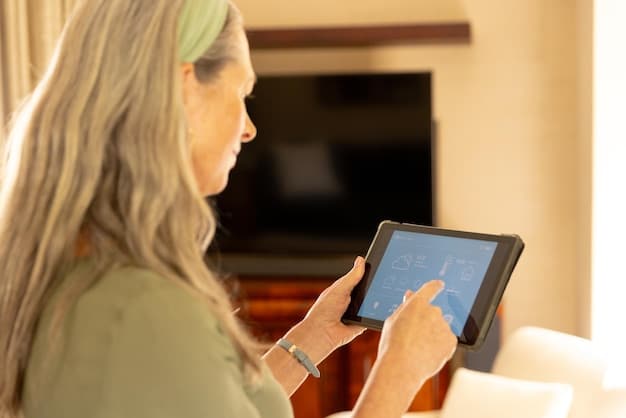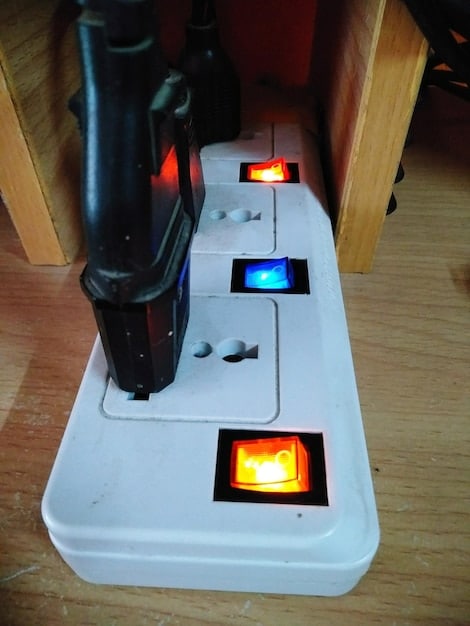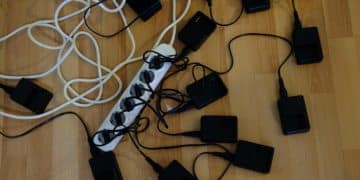Smart Home Energy Monitors: Track Electricity & Find Energy Vampires

Smart home energy monitors help you track electricity usage in real-time, identify energy vampires, and make informed decisions to reduce energy consumption and save money on utility bills.
Are you tired of high electricity bills? Do you suspect energy vampires are lurking in your home, silently driving up your costs? Smart home energy monitors: Tracking Your Electricity Usage and Identifying Energy Vampires can help you take control of your energy consumption and put an end to wasteful spending, so keep reading!
Understanding Smart Home Energy Monitors
Smart home energy monitors are innovative devices that provide real-time data on your home’s electricity consumption. They empower you to understand exactly how much energy each appliance and device is using, enabling you to identify areas where you can conserve and save.
These monitors provide detailed insights that can help you make informed decisions about your energy usage.
How Smart Home Energy Monitors Work
Smart home energy monitors typically work by connecting to your home’s electrical panel or individual circuits. They use sensors to measure the flow of electricity and transmit this data to a central hub or a smartphone app.
The data is then processed and presented in an easy-to-understand format, allowing you to track your energy usage patterns.
Types of Smart Home Energy Monitors
There are mainly two types of smart home energy monitors:
- Whole-house monitors: These devices track the total energy consumption of your entire home. They are typically installed in the electrical panel and provide a comprehensive overview of your energy usage.
- Individual device monitors: These monitors plug into outlets and measure the energy consumption of specific appliances or devices. They are ideal for identifying energy vampires and understanding the energy usage of individual items.
Choosing the right type of monitor depends on your specific needs and goals.
In conclusion, understanding smart home energy monitors involves recognizing their functionality, exploring their methodologies, and distinguishing between different categories. This knowledge empowers you to make informed choices about integrating these devices into your home.

Benefits of Using Energy Monitors
Implementing smart home energy monitors offers a multitude of benefits, catering to both environmental consciousness and financial savings. They enhance your ability to make informed decisions regarding energy use.
These devices provide valuable insights that can lead to significant improvements in your energy efficiency.
Reducing Energy Consumption
One of the primary benefits of using smart home energy monitors is that they help you reduce your overall energy consumption. By identifying the appliances and devices that consume the most energy, you can take steps to use them more efficiently or replace them with energy-saving alternatives.
This leads to practical steps that reduce your carbon footprint and save money.
Saving Money on Utility Bills
Reducing energy consumption directly translates to lower utility bills. Smart home energy monitors help you identify areas where you can save money and make adjustments to your energy usage habits.
They help you to recognize wasted energy and make informed choices.
Identifying Energy Vampires
Energy vampires, also known as phantom loads, are devices that continue to consume energy even when they are turned off. Smart home energy monitors can help you identify these energy vampires and unplug them or use power strips to cut off their power supply when they are not in use.
This significantly reduces your standby usage, optimizing your energy savings.
In summary, smart home energy monitors provide a range of benefits, including lowered energy consumption, savings on utility bills, and the detection of energy-draining devices. By leveraging these benefits, users can create more sustainable and cost-effective home environments.
Key Features to Look For
When selecting a smart home energy monitor, numerous features should be considered to ensure it meets your specific needs and preferences. Factors such as real-time monitoring, data analysis, and compatibility with other smart home devices play a crucial role.
Choosing the right monitor can significantly enhance your energy-saving efforts.
Real-Time Monitoring
Look for a monitor that provides real-time data on your energy consumption. This allows you to see exactly how much energy you are using at any given moment and identify patterns or spikes in usage.
Real-time monitoring promotes immediate adjustments and smarter usage habits.
Data Analysis and Reporting
A good smart home energy monitor should offer data analysis and reporting features. This allows you to track your energy usage over time, identify trends, and generate reports that can help you make informed decisions.
Data analysis provides insights for continuous improvement in energy efficiency.
Compatibility with Smart Home Devices
Ensure that the energy monitor is compatible with other smart home devices and platforms. This allows you to integrate it into your existing smart home ecosystem and automate energy-saving tasks.
Compatibility ensures a seamless integration with your existing devices.
The key features of a smart home energy monitor include real-time monitoring, data analysis, and integration capabilities with other smart home devices. These features collectively provide a comprehensive understanding of energy consumption and enable proactive energy management.

Installation and Setup
Installing and setting up a smart home energy monitor can vary depending on the specific device and its features. Generally, it’s important to follow instructions carefully to integrate the system into your home correctly.
Proper installation is key to accurate readings and effective monitoring.
DIY Installation vs. Professional Installation
Some smart home energy monitors are designed for DIY installation, while others may require professional installation. If you are comfortable working with electrical wiring, you may be able to install a whole-house monitor yourself. However, if you are not confident in your abilities, it is best to hire a qualified electrician.
Professional installation ensures safety and accuracy.
Step-by-Step Installation Guide
Follow a detailed step-by-step guide. This process includes:
- Turning off the power.
- Connecting the monitor to the electrical panel.
- Activating and configuring the monitor.
Careful adherence to each step is necessary for a successful setup.
Troubleshooting Common Issues
As with any technical device, you may encounter issues during the setup or operation of your smart home energy monitor. Common issues include connectivity problems, inaccurate readings, and software glitches. Consult the manufacturer’s documentation or online resources for troubleshooting tips.
Effective troubleshooting ensures ongoing reliability and precision.
In summary, installation and setup of a smart home energy monitor involve deciding between DIY or professional installation, following precise setup guides, and resolving common technical problems as necessary. These steps are essential for guaranteeing accurate and efficient energy monitoring.
Choosing the Right Monitor for Your Home
Selecting the ideal smart home energy monitor requires careful consideration of your home’s energy usage, budget, and desired features. There are varying factors to consider.
Matching a monitor to your unique requirements is key to long-term satisfaction.
Assess Your Energy Usage
Start by assessing your current energy usage patterns. Identify the appliances and devices that consume the most energy and determine whether you want to monitor your entire home or specific items. This will help you choose the right type of monitor and its features.
Understanding your energy profile guides your selection process.
Consider Your Budget
Smart home energy monitors range in price from relatively inexpensive plug-in devices to more expensive whole-house monitors that require professional installation. Set a budget and look for monitors that offer the features you need within your price range.
Financial planning ensures you find a cost-effective solution.
Read Reviews and Compare Features
Before making a purchase, read reviews from other users and compare the features of different monitors. Look for monitors that are accurate, reliable, and easy to use. Also, consider factors such as compatibility with your smart home ecosystem and customer support.
User reviews provide valuable insight into product performance and reliability.
Selecting the right smart home energy monitor involves evaluating your energy consumption, setting a budget, and comparing product features and reviews. This holistic approach ensures that you select a device that meets your home’s unique energy management needs.
Tips for Maximizing Energy Savings
Once your smart home energy monitor is up and running, you can employ various tactics to optimize your energy savings. These can lead to additional strategies for improving efficiency, in addition to the benefits of the monitor.
Combined, these efforts maximize your savings and overall sustainability.
Set Energy-Saving Goals
Set realistic energy-saving goals and track your progress over time. Use the data provided by your smart home energy monitor to identify areas where you can reduce your energy consumption and make adjustments to your habits.
Goal setting provides clear direction and accountability.
Automate Energy-Saving Tasks
Use your smart home energy monitor in conjunction with other smart home devices to automate energy-saving tasks. For example, you can set your thermostat to automatically adjust the temperature when you are away from home or use smart plugs to turn off devices that are not in use.
Automation reduces wasted energy without manual intervention.
Regularly Monitor and Adjust Your Usage
Monitor your energy usage regularly and make adjustments as needed. Pay attention to changes in your energy consumption patterns and identify any new energy vampires that may be lurking in your home. With ongoing monitoring you remain agile.
Consistent evaluation enables proactive energy management.
Successfully maximizing energy savings with a smart home system includes establishing clear energy-saving goals, automating energy-saving procedures, and regularly monitoring and adjusting your energy utilization. This integrated methodology ensures continuous progress in optimizing energy efficiency.
| Key Point | Brief Description |
|---|---|
| 💡 Real-Time Monitoring | Track energy use instantly. |
| 💰 Cost Savings | Lower utility bills by reducing waste. |
| 🧛 Identify Vampires | Find devices using energy when off. |
| 🏠 Smart Integration | Connect with other smart home devices. |
FAQ
A smart home energy monitor is a device that tracks your home’s electricity usage in real time. It can help you identify energy consumption patterns and potential savings.
Energy monitors save money by pinpointing areas where you are wasting energy, allowing you to make informed decisions to reduce consumption and lower your utility bills.
Some energy monitors are designed for DIY installation, while others require professional installation. If wiring is involved, consider hiring an electrician for safety.
Energy vampires are devices that continue to consume electricity even when turned off. Energy monitors can help you identify and eliminate these wasteful devices from your home.
Many energy monitors are compatible with other smart home devices, allowing seamless integration. Check compatibility before purchase to ensure it works with your ecosystem.
Conclusion
In conclusion, smart home energy monitors offer a powerful tool for understanding and managing your home’s electricity usage. By tracking consumption, identifying energy vampires, and providing valuable data, these monitors empower you to make informed decisions, reduce waste, and save money on your utility bills.





